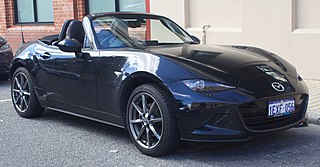Roo, formally the Roo Motor Car Manufacturing Company was an Australian company set up to produce automobiles from Australian-sourced components. [1]
It was founded in 1917 by Rupert Jeffkins, a local car racing identity, and W. B. Foulis, a Sydney-based engineer. [1]
Jeffkins had achieved international fame in 1912 as Ralph DePalma's riding mechanic in the second annual Indianapolis 500. They led for 195 (of 200) laps before a conrod tore a hole in the crankcase two laps from the end. Jeffkins and De Palma pushed the crippled car across the finish line in a futile endeavor that bought the crowd of 80,000 spectators to their feet. However, Indianapolis rules mandated that all entries move under their own power, so DePalma's final number of laps is recorded as 198, the push across the line bringing them only to the beginning of the final lap. They officially finished 11th. They received no prize money, but photographs of the dramatic push from the fourth turn to the finish line were published around the world.
Jeffkins returned to Australia in 1914 with films of the first two (1911 and 1912) Indy 500s. He toured the country narrating the films and publicizing his other American automobile exploits.
In 1917 Jeffkins and William B. Foulis built two prototype roadsters with minimalist two seater bodies, named by Lord Mayor of Sydney Richard Meagher, proudly promoting that every component was locally made. These featured twin cylinder, air cooled, horizontally opposed engines that were designed and built by Foulis. Jeffkins and Foulis used the first Roo for test and promotional tours of the Eastern States of Australia, driving from Melbourne to Sydney and back, averaging between 45 and 50 miles per gallon. [1] [2]
The company purchased land in Burwood for a factory but this was never built. [1] [2]
Once enough capital had been raised Jeffkins and Foulis planned to mass-produce two models, the "Raceabout" and a better equipped "Standard" that had more substantial bodywork and lower gearing. The "Raceabout" was meant to retail for the same price as a Model T Ford.[ citation needed ]
A third Roo was under construction when the solicitor who was the major financial backer withdrew support, causing the collapse of the company. [2]
Jeffkins attempted to revive the concept in 1929, but it did not progress beyond the blueprint stage.
Foulis produced the engines for the Southern Cross cars in the 1930s.

A roadster is an open two-seat car with emphasis on sporting appearance or character. Initially an American term for a two-seat car with no weather protection, usage has spread internationally and has evolved to include two-seat convertibles.

Front-wheel drive (FWD) is a form of engine and transmission layout used in motor vehicles, where the engine drives the front wheels only. Most modern front-wheel-drive vehicles feature a transverse engine, rather than the conventional longitudinal engine arrangement generally found in rear-wheel-drive and four-wheel drive vehicles.

Raffaele "Ralph" De Palma was an Italian-American racecar driving champion who won the 1915 Indianapolis 500. His entry at the International Motorsports Hall of Fame estimates that he won about 2,000 races. DePalma won the 1908, 1909, 1910, and 1911 American AAA national dirt track championships and is credited with winning 24 American Champ car races. He won the Canadian national championship in 1929. DePalma estimated that he had earned $1.5 million by 1934 after racing for 27 years. He is inducted in numerous halls of fame. He competed on boards and dirt road courses and ovals.
This article discusses the year-by-year history of the Indianapolis 500 race.

The 1912 Indianapolis 500-Mile Race, or International 500-Mile Sweepstakes Race, the second such race in history, was held at the Indianapolis Motor Speedway on Thursday, May 30, 1912.
No race is won until the tape is crossed and I realized that all the time. It's hard luck, but it's all in the game.
I did my best, and since I've lost out, I'm for the man who picked the prize.

August Samuel Duesenberg was a German- born American automobile and engine manufacturer who built American racing and racing engines that set speed records at Daytona Beach, Florida, in 1920; won the French Grand Prix in 1921; and won Indianapolis 500-mile races, as well as setting one-hour and 24-hour speed records on the Bonneville Salt Flats in Utah in 1935. He also shared with his older brother, Frederick S. "Fred" Duesenberg, patents filed in 1913 and renewed in 1918 for a four-cylinder engine design and the Duesenberg Straight 8.

The 4th International 500-Mile Sweepstakes Race was held at the Indianapolis Motor Speedway on Saturday, May 30, 1914.
The Southern Cross was an Australian automobile produced between 1931 and 1935. Built by the Marks Motor Construction Company it was intended to retail for under 300 pounds. Volume production of the "Airline" Sedan was planned for 1935 but the marque died with the Chairman, Sir Charles Kingsford Smith.

Mercer was an American automobile manufacturer from 1909 until 1925. It was notable for its high-performance cars, especially the Type 35 Raceabout.

Charles Cleveland Merz was an American racecar driver, military officer, engineering entrepreneur, and racing official. Active in the early years of the Indianapolis 500, he later became Chief Steward of the Memorial Day Classic.
The 1911 Grand Prix season consisted of Grand Prix races in the United States and Europe. It was a significant year as European racing gradually came out of the doldrums. A Grand Prix was held in France again. The first Indianapolis 500 was held at Indianapolis Motor Speedway, joining the American Grand Prize as a leading race.
The 1912 Grand Prix season saw Grand Prix motor racing in Europe and the United States. The growing economic confidence and interest from car manufacturers saw bigger fields and more races in the season. The French Grand Prix was held for the first time since 1908 and staged at Dieppe. The American Grand Prize was held in Milwaukee, moving from its previous home in Savannah.

The 1914 Grand Prix season consisted of Grand Prix races across Europe and the United States until abbreviated by the outbreak of World War I.

The 1921 Grand Prix season saw motor racing in Europe blossom again. The French Grand Prix was held for the first time since 1914, at La Sarthe, Le Mans. and the inaugural Italian Grand Prix was held in Montichiari, near Brescia. The 3-litre formula of the AIACR, already in use at Indianapolis, was adopted by those Grand Prix meaning manufacturers could design on a common formula.

The Cunningham automobile was a pioneering American production automobile, one of the earliest vehicles in the advent of the automotive age. It was produced from 1896 to 1931 in Rochester, New York by James Cunningham, Son and Company.

The "'Jackson Automobile Company'" was an American Brass Era automobile manufacturer located in and named for Jackson, Michigan. The company produced the Jackson from 1903 to 1923 and the 1903 Jaxon steam car and the 1904 Orlo.

The Harvest Auto Racing Classic was a series of three automobile races held at the Indianapolis Motor Speedway on Saturday September 9, 1916. The meet, held four months after the 1916 Indianapolis 500, featured a 20-mile race, a 50-mile race, and a 100-mile race. The main event, a 100-mile Championship Car race, paid points towards the 1916 AAA National Championship. Johnny Aitken won all three races, two of which had a margin of victory of less than a car length.
The 1919 Grand Prix season was the first season following the armistice that ended World War I in November 1918. European economies were struggling, and many automotive firms had to recover and retool from military production. So, there was very little racing activity as it took time for the companies and populations to recover. As the world rebuilt there were only two major races held in the year – the Indianapolis 500 and the Targa Florio.
The 1920 Grand Prix season saw further activity in motor-racing gradually increase. Europe was still recovering from the end of the war and the terrible pandemic that swept the continent. Automotive companies were gradually re-establishing themselves after re-tooling from a wartime footing and getting production lines rolling again.
The Marks-Moir car evolved through several iterations between 1921 and 1935. It was initially a collaboration between Dr A.R. Marks and W. Moir who designed an unconventional, chassis-less car to be manufactured in Australia. The original design was built in England in 1922. It was a two-seater that featured a body made of laminated wood. The motor, supplied by Wolsely, was mounted longitudinally behind the front seats. Two chains took the drive to the solid rear axle and differential action occurred within the rear wheel hubs. This increased ground clearance and minimized power loss compared to more orthodox driveline configurations. It was exhibited at Australia House in London for some months before Marks and Moir bought the prototype and some components to Australia.